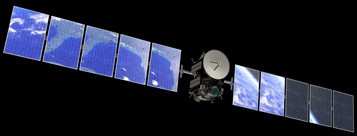Thrifty Powerplant Will Power Probe To Asteroid Rendezvous
NASA's Dawn spacecraft is flying high... now that it has finally
made it into space. NASA tells ANN the spacecraft successfully
completed the first test of its ion propulsion system over the
weekend. The system is vital to the success of Dawn's eight-year,
three-billion-mile journey to asteroid Vesta and dwarf planet
Ceres.

"Dawn is our baby and over the weekend it took some of its first
steps," said Dawn project manager Keyur Patel of NASA's Jet
Propulsion Laboratory in Pasadena, CA. "We have two months more
checkout and characterization remaining before Dawn is considered
mission operational, but this is a great start."
Members of the Dawn mission control team have been sending up
commands and checking out spacecraft systems ever since its
successful launch on September 27. The first test firing of one of
Dawn's three ion engines was the culmination of several days of
careful preparation.
On Saturday, October 6 at 1807 PDT, the ion propulsion system
began thrusting. Over the next 27 hours, spacecraft controllers and
navigators at JPL monitored the engine's performance as it was put
through its paces.
"We evaluated the engine's capabilities at five different
throttle levels," said Jon Brophy, the Dawn project's ion
propulsion manager at JPL. "From flight idle through full throttle,
the engine performed flawlessly."
Dawn's ion engines are extremely frugal powerhouses. The 27
hours of thrusting from the ion engine resulted in the consumption
of less than .28 kilograms (10 ounces) of the spacecraft's xenon
fuel supply -- less than the contents of a can of soda. Dawn's fuel
tank carries 425 kilograms (937 pounds) of xenon propellant. Over
their lifetime, Dawn's three ion propulsion engines will fire
cumulatively for about 50,000 hours (over five years) -- a record
for spacecraft.
Dawn will begin its exploration of asteroid Vesta in 2011 and
the dwarf planet Ceres in 2015. These two icons of the asteroid
belt have been witness to so much of our solar system's history. By
utilizing the same set of instruments at two separate destinations,
scientists can more accurately formulate comparisons and contrasts.
Dawn's science instrument suite will measure shape, surface
topography, tectonic history, elemental and mineral composition,
and will seek out water-bearing minerals. In addition, the Dawn
spacecraft itself and how it orbits both Vesta and Ceres will be
used to measure the celestial bodies' masses and gravity
fields.
The Dawn mission to asteroid Vesta and dwarf planet Ceres is
managed by JPL for NASA's Science Mission Directorate, Washington,
DC. The University of California, Los Angeles is responsible for
overall Dawn mission science.

Other scientific partners include: Los Alamos National
Laboratory, New Mexico; Max Planck Institute for Solar System
Research, Katlenburg, Germany; DLR Institute for Planetary
Research, Berlin, Germany; Italian National Institute for
Astrophysics, Rome; and the Italian Space Agency. Orbital Sciences
Corporation of Dulles, Virginia, designed and built the Dawn
spacecraft.
 ANN's Daily Aero-Linx (05.02.24)
ANN's Daily Aero-Linx (05.02.24) ANN's Daily Aero-Term (05.02.24): Touchdown Zone Lighting
ANN's Daily Aero-Term (05.02.24): Touchdown Zone Lighting Aero-News: Quote of the Day (05.02.24)
Aero-News: Quote of the Day (05.02.24) ANN FAQ: Contributing To Aero-TV
ANN FAQ: Contributing To Aero-TV NTSB Final Report: Cirrus Design Corp SR20
NTSB Final Report: Cirrus Design Corp SR20




